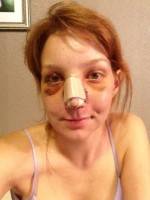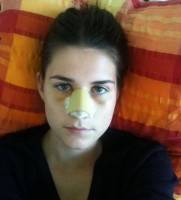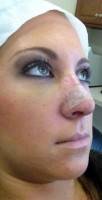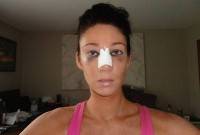Rhinoplasty Recovery Time
Rhinoplasty recovery time would depend on the exact procedures being done.
If the bones are broken, technically referred to as osteotomies, they can take about 6 weeks to heal.
In my practice, I see patients at one week to remove any external or internal splints which may have been placed during surgery.
Most patients return to non-strenuous normal activities within a few days, though one week is a safe time period.
I ask patients who underwent osteotomies to refrain from contact sports, picking up children, or playing with pets for 6 weeks. Swelling after a nose job, or rhinoplasty, can take up to a year to resolve.
Though this is a gradual process and most of the swelling is gone after a month, patients must understand that to see the ultimate results of the procedure can take up to a year in some cases. (D.J. Verret, MD, Dallas Facial Plastic Surgeon)
Recovery Time after Rhinoplasty surgery
I recommend planning 4-5 days off from work. An important caveat, though is that some patients may have black eyes.
Avoid any activity that will raise your blood pressure for 2 weeks post-Rhinoplasty.
I also advise abstaining from high impact activities (jumping, running) for 6 weeks after Rhinoplasty. I usually leave an external splint for four – to five – days.
It normally will take almost 18 months before you see the final shape of your new nose. (Paul C. Zwiebel, MD, Denver Plastic Surgeon)
Rhinoplasty Recovery Time
Although the time it takes to recover from a rhinoplasty can vary from patient to patient depending on their biology as well as the type of rhinoplasty performed, it typically takes 7-10 days to look good enough to go in public without turning any heads. (Amir M. Karam, MD, San Diego Facial Plastic Surgeon)
You do not indicate your age or sex, but in general younger, female patients do very well with rhinoplasty. I favor the external approach and at one week the splint comes off as well as the sutures. Most of my patients will return to work or school looking a little swollen. Noses can take months or even years to achieve the final result but most of my patients feel comfortable going out into public at a week.
A rhinoplasty in a male or a female with thick skin can be more complicated as the swelling can be more pronounced and last longer. Gentle technique and conservative changes often result in rapid recovery following rhinoplasty. (Ivan Wayne, MD, Oklahoma City Facial Plastic Surgeon)
How Long to Heal After A Rhinoplasty?
Rhinoplasty recovery time has several components:
- Bruising: May have little to no bruising depending on technique and surgeon. Can be present up to 10 days in some cases.
- Facial swelling: Normal to have swelling along face, most disappears around one week.
- Nasal Bones: If nasal bones are broken (term osteotomy) it will take up to 3 months to regain strength. Avoid contact sports during this time.
- Intranasal swelling (Mucosal): Most swelling intranasal disappears after one month.
- Dorsal swelling: Improves dramatically during from first week to one month. Subtle changes along dorsum can present for years
- Nasal tip swelling: Less nasal tip swelling after one week.
Should generally look pretty good by end of month one depending on type of rhinoplasty and individual characteristics. It may take years to see final subtleties in nose. (Anil R. Shah, MD, Chicago Facial Plastic Surgeon)
Rhinoplasty Recovery
Rhinoplasty is an outpatient, or ambulatory procedure, which means you come in and go home on the same day. It is usually performed under general anesthesia, but depending on the complexity, may be performed under local anesthesia with or without sedation.
At the end of the operation, there will be a cast on your nose, and possibly a small amount of packing inside . Many rhinoplasties will not require packing. This small amount of packing can be removed by yourself the next day with clean tweezers, or you can come into the office to have it removed.
It is important to sleep with your head elevated for the first few days, and put cold compresses over your eyes to reduce swelling.
The peak of the swelling is the morning of the second day, and then the swelling will start to go down. The cast will come off either 6 or 7 days after the surgery.
Most people are able to return to school or work about 1 week after the surgery. (Jennifer Levine, MD, New York Facial Plastic Surgeon)
Nose job recovery time and Downtime
This is a difficult question to answer for several reasons. Each individual undergoing nose job surgery swells differently.
In general, about 80% of the swelling is gone within a month with the rest slowly dissipating over the course of a year. Usually patients look pretty good at the end of two weeks.
That period is what I call “medical downtime” in that you are pretty much free to do all of your normal activities after two weeks.
After that, you have “social downtime” which varies tremendously between patients. For example, some of my patients do not care if others know if they have had surgery and others really don’t want anyone to know.
If you are part of the latter camp, you would want to wait longer. Usually at a month, even though you and your surgeon can see swelling, it is very difficult for most to know that you’ve had an operation. (Michael M. Kim, MD, Portland Facial Plastic Surgeon)
Rhinoplasty Recovery Time
In general, most nose job patients are “presentable” 1-week post surgery, at which time the cast is removed.
There will be some swelling and bruising at this time. This can be concealed with makeup.
Expect most bruising to be completely resolved by 2 weeks. The first wave of decrease in swelling will then occur by about 3 weeks, the second wave by about 3 months; at the 3-month mark, you won’t see any appreciable swelling.
In reality, it takes up to a year for all the swelling to completely dissipate such that you can really decipher the final result. Factors that affect swelling and bruising are:
– Pre-op: pre-existing bleeding conditions, nutritional supplements (you should avoid the following before surgery: vitamin E, Ginseng, Ginkgo, fish oils), blood thinners (Coumadin, Aspirin, Ibuprofen, Plavix)
– Intra-op: whether or not osteotomies (cutting/re-shaping of the nasal bones) was performed, surgical technique (open versus closed-approach; closed approach is less traumatic to the nose, and is less likely to produce significant swelling and bruising. For the right patient, my preference is the closed (aka “endonasal”) nose job), duration of the surgery
– Post-op: the patient’s own healing times, avoidance of medications that cause bleeding/bruising, use Arnica, avoidance of strenuous physical activity for at least 2 weeks; keep head elevated and utilize icepacks to forehead and cheeks for 48-72 hours after surgery (as directed by your surgeon)
We generally apply nasal taping and a cast postoperatively, which is left on for 1-week. We don’t typically utilize nasal taping after this period. Patients should avoid sun exposure (i.e. use sunscreen) for the next year to avoid any nasal skin changes. And, if you’re a smoker, this is a great impetus to help you quit smoking since continuing to smoke can have a negative impact on your healing process.
While it all might sound a bit complicated, for the vast majority of patients, nose job is a smooth process that requires some patience initially (from patient and surgeon!), but in the end is well worth the wait. (Ashlin Alexander, MD, Toronto Facial Plastic Surgeon)
Healing time for nose job surgery
The recovery time for nose job surgery can vary depending on type of procedure performed. A minor nose job, such as a slight hump reduction, may require only a week or so recovery time.
However most nose job surgery requires more significant work such as tip refinement, building the bridge up or down in height, narrowing the bridge, or narrowing the nostrils. When such maneuvers are required, a longer healing time can be expected.
On average, the patient can expect to wear a nasal cast and/or taping on the nose for up to 5 to 14 days after surgery. Once the cast and/or tape is removed, patients can expect to have swelling on the nose. Approximately 2 weeks after surgery, most bruising has resolved and many patients feel comfortable returning back to work and engaging in social events.
Swelling is still expected at this point, and the nose will continue to settle. In the first month after surgery, patients can notice significant changes on a daily basis. For primary nose job surgeries, healing can continue for anywhere from 3 to 6 months after surgery. Revision nose job surgeries can take significantly longer. (Edward S. Kwak, MD, Manhattan Facial Plastic Surgeon)
Rhinopasty recovery and downtime
My patients typically take 1 week off work after surgery. The cast and sutures come out at the end of the first week and patients are typically presentable at this point. The nose is still swollen, but it is a better shaped, smaller nose that is swollen. The recovery is not painful. I give tylenol #3 which is a gentle pain medication and patients do very well with just this or plain Tyleol. (Jonathan Pontell, MD, FACS, Philadelphia Facial Plastic Surgeon)
There are two parts to recovery. First there is the bruising, etc that happens after a nose surgery. This is often what patients are concerned with as it is a sign of surgery.
Usually this takes about 10 days to resolve. If you can take some medications, such as arnica , before surgery, this will greatly help reduce your bruising.
Finally, there is the swelling/edema that comes from changing the shape of your nose. This takes longer to resolve. It can take several months up to a year to finally resolve.
However, there usually is a dramatic improvement in the swelling after the first 6 weeks after surgery. Talk with your doctor about upcoming events in your life to see if the timing of surgery is possible. (Sandy Sule, MD, Dallas Facial Plastic Surgeon)
If you’re having an open nose surgery, the sutures and splint come off in one week. Some patients require additional taping for another seven days.
Your result will be apparent immediately; however, your final result may develop over the course of several months up to one year.
During this recovery time, especially in the earlier weeks, your nose may occasionally swell do to inactivity, and your true result may be difficult to appreciate. However, this is temporary, and your result will continue to develop over time. (Frank L. Stile, MD, Las Vegas Plastic Surgeon)
The first two weeks are generally the worst. In your first week you will generally have a splint over the top of your nose for protection as well as internally. There will also be considerable bruising around your cheeks and possibly your eyes.
At your first post operative visit your surgeon should remove your splint and the external sutures. You will still however be bruised and swollen. By two weeks most of the bruising will subside however your nose will still be swollen. At this point you should be able to go in public and not feel that everyone is looking at you.
Your nose will continue to improve over the next few months as the swelling resolves more and the features of your nose become more prominent. (Richard Bloom, MBBS, FRACS, Melbourne Plastic Surgeon)
Definition of “recovery” is different for everyone
The initial “beaten up” appearance after nose surgery can be gone within the first 7-10 days if you don’t experience much bruising. Bruising is more common and extensive where there is bone fracturing taking place.
True recovery time, meaning ALL of the bruising is gone, can be technically more than one year, however patients enjoy their results within 2-4 weeks, knowing that after 4 weeks there are still minor improvements to be seen. (Javier Davila, MD, New Haven Plastic Surgeon)
Recovery time from rhinoplasty
Average rhinoplasty recovery time as follows: My casts come off between the third and seventh day. Patients may fly on the eighth day if they are returning to a home destination.
Patients may resume all normal activity by the one month. Naturally, there are deviations from this but after 26 years of experience that is the usual recovery time. (Carlos Wolf, MD, Miami Facial Plastic Surgeon)
Nose surgery recovery time usually lasts at least 6 weeks in terms of noticeable swelling. the more minimal the work the more minimal the recovery. I do quite a number of nose surgery surgery and in my practice nose surgery recovery time usually lasts at least 6 weeks in terms of noticeable swelling. I find that the more minimal the work the more minimal the recovery. (Hani Sinno, MD, Montreal Plastic Surgeon)
It can take up to one year for full recovery. Every patient is different as the skin is different as well. Recovery time for a rhinoplasty is approximately two weeks. One week for the cast to be removed and the second week for majority of the swelling and bruising to subside.
Please keep in mind that although the changes may be subtle a nose surgery takes up to a year to heal. (Cory Torgerson, MD, PhD, FRCSC, Toronto Facial Plastic Surgeon)
What to expect after nose surgery recovery time – timeline for recovery
The timeline for nose surgery recovery varies depending on the extent of the surgery and the approach used. In general, I advise patient to plan for 7-10 days of recovery time. The first few days the nose is quite congested and there will be some drainage present. Depending on the extent of bony work, there may be some bruising around the eyes that will fade over the 10 day period.
I usually place a small splint on the outside of the nose and cover this with skin colored tape. I do NOT use any packing inside the nose which makes the postop visit much more comfortable. Depending on the amount of septal work, I may place thin splints to help support the septum during the healing process.
I advise my patients to rest, drink plenty of fluids and avoid physical activity until their first postop visit at 6-7 days. My patients routinely say that the recovery process was easier than they expected. (Krista Lee Olson, MD, Houston Facial Plastic Surgeon)



